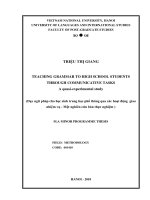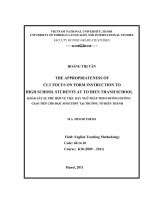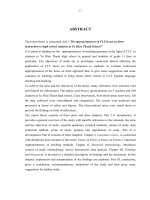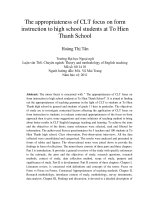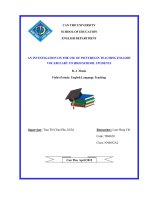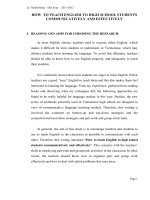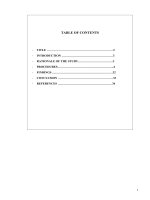skkn HOW TO TEACH ENGLISH TO HIGH SCHOOL STUDENTS COMMUNICATIVELY AND EFFECTIVELY
Bạn đang xem bản rút gọn của tài liệu. Xem và tải ngay bản đầy đủ của tài liệu tại đây (234.53 KB, 13 trang )
Le Thanh Hung – Dau Giay – 2011-2012
HOW TO TEACH ENGLISH TO HIGH SCHOOL STUDENTS
COMMUNICATIVELY AND EFFECTIVELY
I. REASONS AND AIMS FOR CHOOSING THE RESEARCH:
In most English classes, teachers tend to overuse either English, which
makes it difficult for slow students to understand, or Vietnamese, which may
distract students from learning the language. To avoid this dilemma, teachers
should be able to know how to use English properly, and adequately to teach
their students.
It is commonly known that most students are eager to learn English if their
teachers use a good, “easy” English to teach them and this also makes them feel
interested in learning the language. From my experience, gathered from reading
books and observing what my colleagues did, the following approaches are
found to be really helpful for language teacher in this case. Besides, the new
series of textbooks presently used in Vietnamese high school are designed in
view of communicative language teaching method. Therefore, this writing is
involved the comment on bottom-up and top-down strategies and the
connection between these strategies and pair work and group-work tasks.
In gerneral, the aim of this study is to encourage teachers and students to
use as much English in the classroom as possible to communicate with each
other. Therefore, this writing introduce “How to teach English to high school
students communicatively and effectively”. This concerns with the teachers’
skills at employing pairwork and groupwork activities in the classroom. In other
words, the teachers should know how to organize pair and group work
effectively and how to deal with initial problems that may arise.
Page.1
Le Thanh Hung – Dau Giay – 2011-2012
II. BACKGROUND:
1. Pairwork and groupwork:
Foreign language learners, especially high school students are often shy, and
find it hard to express themselves in the language in front of the public at the
beginning stage. Hence, the role of the language teachers is to make their students
get used to the language and feel confident in using the language. In this case,
pair/group work activities do help as Ur (Ur 1998: 210) suggested.
Advantages, disadvantages :
For certain types of activity, pairwork and groupwork have number of
advantages over working with the whole class together. Teachers should be aware
of the advantages, the problems to find the solutions to these problems .
Here are some main advantages and problems:
Advantages
Problems
More language practice
Noise
Students are more involved
Students make mistakes
Students feel secure, confident
Difficult to control
Students help one another
…………………..
Save time
2. Bottom-up and top-down strategies:
What are bottom-up and top-down strategies? As Harmer mentioned, “In
top – down processing reader or listener gets a general view of the listening or
reading passage by, in some way, absorbing the overall view of the picture” and
“in bottom-up processing, the reader or listener focuses on individual words and
phrases and achieves understanding by stringing these detailed elements
together to build up a whole” (Harmer 2001 p: 201). This is to say that top down is the process in which students use their schematic knowledge to access
to the topic of the passage, and bottom – up is the process in which students use
Page.2
Le Thanh Hung – Dau Giay – 2011-2012
their knowledge of language to explore the passage to have detailed ideas of the
text.
III. PARTICIPANTS AND METHODS:
This research was applied to three classes of tenth graders ranging from
fourteen to fifteen years old (10C1, 10C2, 10C3). Each class contains forty five
to fifty participants who are of mixed genders and language ability. In terms of
language competence, most of them might be considered as pre-intermediate
students. The methods used to conduct the study include:
- Observation.
- Journal.
- Dialogue.
IV. CONTENT AND APPLICATION:
1. A combination of the two strategies in teaching reading and listening:
Like other teachers, I had an experience of using both of these strategies,
but separately, to teach receptive skills, i.e. reading and listening skills. Then I
found that my students did not understand the topic clearly. For example, when
I taught them the reading about “science “, I applied the top – down approach to
one class and bottom – up approach to another class. And then the results I got
were unsatisfactory. The students in the first class seemed not to know much
about the “science world”, and the students in the other class just knew
something about the vocabulary, but not the whole text. However, after reading
books and observing what some of my colleagues did in their teaching, I
realized that we could make a language class become more interesting and
effective by putting these two approaches together. I also met this point of view
in Harmer’s book in which he pointed out, “ it is probably most useful to see
acts of reading and listening as interaction between top-down and bottom-up
processing” (Harmer 2001 : 201). Following are two suggestions of using the
strategies in teaching listening and reading skills.
Page.3
Le Thanh Hung – Dau Giay – 2011-2012
1.1 The strategies in teaching listening:
Top-down processing
Expectations based
on prior knowledge.
(content schemata)
Expectations
based on
discourse and
sociocultural
Expectations based
on the assessment of
context
Pragmatic
s
Metacognition
Interpretation of
spoken discourse
(input)
Language knowledge
(phonology
vocabulary, grammar,)
Listening
Strategies
Bottom-up processing
Page.4
Le Thanh Hung – Dau Giay – 2011-2012
1.2 The strategies in teaching reading
Top-down processing
Expectations based
on prior knowledge.
(content schemata)
Expectations based
on discourse and
sociocultural
knowledge.
(formal schemata)
Expectations based on
the assessment of
context
Pragmatics
Metacognition
Interpretation of
spoken discourse
(input)
Language knowledge
(phonology
vocabulary, grammar,)
Listening
Strategies
Bottom-up processing
Page.5
Le Thanh Hung – Dau Giay – 2011-2012
2. Organizing pairwork and groupwork:
The success of group or pair work depends on some extents, i.e. the
surrounding social climate, how habituated the class is to using it, the selection of
an interesting and stimulating task whose performance is well done within the
ability of the group or pair, and especially effective and careful organization.
2.1. Giving instructions:
The instructions that are given at the beginning are crucial. If the students do
not understand exactly what they have to do, there will be wate of time, confusion,
lack of effective practice, or even possible loss of control. Therefore, the teacher
should select tasks that are simple enough to describe easily; and in monolingual
classes, you may find it cost-effective to explain some or all in the mother tongue.
However, it is advisable to give the instructions communicatively rather than mere
explanation before delivering materials or building groups. And a preliminary
rehearsal or ‘dry run’ of a sample of the activity with the full class can help to
clarify things. If your students have already done similar activities, you will be able
to shorten the process, giving only brief guidelines; It is mainly the first time of
doing something with a class that such care needs to be invested in instructing.
Try to foresee what language will be needed, and have a preliminary quick
review of appropriate grammar or vocabulary. Finally before giving the sign to
start, the teacher should tell the class if there is a time limit, or a set signal for
stopping, and say what it is. If the students simply stop when they have finished the
task, then tell them what they will have to do next. It is wise to have a reserve task
planned to occupy members of groups who finish earlier than expected.
Page.6
Le Thanh Hung – Dau Giay – 2011-2012
2.2. Process:
Teacher goes from group to group or pair to pair, to monitor, and either to
contribute or to keep out of the way whichever is likely to be more helpful. If you
do decide to intervene, you may provide general approval and support; help
students who are having difficultly; keep the students using the target language; or
tactfully regulate participation in a discussion where you find some students are
over dominant and others are silent.
2.3. Ending the task:
Draw the activity to a close at a certain point. Try to finish the activity while
the students are still enjoying it and interested, or only just beginning to flag.
2.4. Feedback:
A feedback session usually takes place in the context of full-class interaction
after the end of the group work. Feedback on the tasks may take such forms as
giving the right solution, if there is one, listening to and evaluating suggestions,
pooling ideas on the board, displaying the meterials the groups/ pairs have
produced. The main objective here is to express appreciation of the effort that has
been invested and its results. Feedback on language may be integrated into this
discussion of the task, or provide the focus of a separate class session later.
3. The connection between the strategies and pair-work/group-work activities:
In terms of students’ point of views and communicative language teaching
method, I have discovered that bottom-up and top-down approaches together help
learners much more in learning the language if teachers link these approaches
with pair-work and group-work activities. In this case, students will find
themselves free to talk and to communicate with one another in their own
language, and they may also feel it interesting to put their heads together and try
to explore the reading text or the listening passage. Accordingly, the students will
become more active and confident to express their ideas, and this is one of the
Page.7
Le Thanh Hung – Dau Giay – 2011-2012
goals of a language class. Let us consider the following experiences as examples
of the application in the classroom.
4. Application in the classroom:
4.1. Pair-work and group work in teaching grammar:
In order to teach the structure “used to /didn’t use to + inf” (Unit 4 English
10, part E. language focus, exercise 2), we may do as following:
Exercise 2: Work in pairs, ask what your friends used to do and didn’t use to
do (Ask about food, sport, music, school, subject ……. ).
- Explain the structure by giving an example:
Ex: Tom often came to class late but now he doesn’t any longer.
- Ask if there is anyone can express the sentence in another way.
Teacher: Now, the whole class, who can put this sentence in another way? Just
speak out.
Students: …… (silent)
Teacher: Ok, now discuss with your friends beside you for one minute……
- Ask some group representative speak out their answers.
- Give comment and correction (if needed)
Teacher: we can say “ Tom used to come to class late”.
Teacher: Mai, what does “used to” mean?
- Follow the previous steps.
- Help the students to understand the structure if their answers are wrong. In this
case the students can have chance to communicate with their friend freely in the
language.
Teacher: Now you are going to talk about things you used to do and things you
didn’t use to do. Look at the exercise. What question can you ask?
Teacher: First, about food. What food did you use to eat for breakfast when you
were small, Hoa?
Hoa: I used to eat ……..
- Teacher writes the basic question on the board:
Page.8
Le Thanh Hung – Dau Giay – 2011-2012
What (food) did you use to eat?
- Teacher asks a few questions round the class to show the kind of conversation
students might have:
Teacher: What kind of music did you use to listen, Huong?
Student: I used to listen to pop music.
Teacher: Pop music? when did you use to listen to it?
( And so on with some others)
- Teacher may ask two students to have similar conversations, while the others
listen.
Teacher: Now, The first, third and fifth row turn back. Ok, you are going to work
in pairs, talking to the one oposite you. Ready? Ask and answer the questions (in
the exercise). First, one person asks, the other answer (about all the topics) then
change the role. Start now.
- Teacher moves quickly round the class, checking that everyone is talking (but do
not try to correct mistakes, as this will interrupt the activity)
- When most pairs have finished, stop the activity. Ask a few students what their
partners said:
Teacher : Now, stop talking. Mai, tell me about Huong. What did she used to do?
Student : She says she used to eat ice cream, listen to pop music and swim in the
afternoon , she liked meat but she didn’t use to eat it.
- Teacher gives feedback:
- Well done……
4.2. Bottom-up and top-down in connection with pair-work and group-work
in teaching listening and reading:
As shown in the charts (page 2 and 3), it is clear that teachers have to
design tasks or questions which provide the students with schemata knowledge as
well as details to help students comprehend the required texts fully. For example,
when I taught the listening lesson of Unit 1 in English textbook 10 (page 16), I
conducted the lesson as following steps.
Page.9
Le Thanh Hung – Dau Giay – 2011-2012
First, in before-listening stage, I made use of top-down approach by
making a general statement about the text “today we are going to listen to a short
talk of a cyclo driver, Mr. Lam, about his daily routine”. This provides the
students with “background” or “prior knowledge” of the text. To some extent,
they might have expectations as to what to listen to in the tape. Then I asked the
students to answer the following questions in groups to give them a chance to
express their ideas as well as practice using the language and talking about the
topic freely:
1.
Look at the pictures and write down as many related words
as you can.
2.
Put the pictures in the order you think the story will go.
3.
From the order you have chosen, tell a story about Mr. Lam.
In the next stages, the students were asked to listen to the tape and do the
True/False task and Gap Filling task which are involved in the application of
bottom-up approach. In this case, the students were asked to explore the text in a
more detailed way.
Another example to illustrate the use of these strategies in the classroom is
related to the reading text of Unit 9 “undersea world” (English textbook 10). The
steps to carry out the lesson are described as following.
First, in while-reading stage, students were asked to read the whole text
once quickly and answer the question “what is the main idea of the passage?”. If
it is taught to students who are not quite good at English, this can be altered by a
multiple choice question (MCQ) of the same content or “underline the sentences
that show the main idea of the text?” In addition, the students were also asked to
find out the main idea of each paragraph. These questions, which are clearly
based on top-down approach, gave the students a general picture of the text.
Page.10
Le Thanh Hung – Dau Giay – 2011-2012
Next, the students were asked to read the text again to answer a number of
questions which are based on bottom-up approach, such as following:
1. How many oceans are there?
2. How much of the earth is covered by seas and oceans?
3. How do scientists now overcome the challenges of the depth?
4. According to the first paragraph, what would happen without
modern technology?
5. …………
After finding out the answers for these bottom-up based questions, the
students could have more details about the text they are reading. Moreover, in
this case, bottom-up approach could also be made use to design such exercises as
“put the sentences which are cut out from the text into their original places” or
“what does the word seabed refer to?” etc. This kind of questions help the
students investigate the text in two important features, i.e. “cohesion” and
“coherence”. Therefore, they could decode the text fully. In other words, the
students might avoid “the mismatch between the reader’s view of the world and
the view that seems to be presented in the text” (Celce – Olshtain 2000:127)
Finally, my lessons usually end with a task asking the students to retell or
summarise briefly what they have learned. By this way, I can make sure that the
students understand the lesson completely.
V. RESULTS:
After a year of conducting the method, to my expectation, I harvested a
satisfactory crop. I have found that most of the students have become more active
in class. They no longer passively wait for the questions or information from the
teacher to interpret the texts. In reading and listening classes, they willingly take
part in negotiating with their partners to explore the texts. This is evident in what
I observed and collected from their journals. Most of them admitted that their
reading and listening skills have improved a lot. In addition, they all reported that
Page.11
Le Thanh Hung – Dau Giay – 2011-2012
when they learn listening or reading they feel very interested because they are not
merely learning these two skills alone, but they also learn to develop other
language skills. Pedagogically, this is what we have expected.
VI. UNANTICIPATED PROBLEMS AND EXPERIENCE:
Although the results I have got are quite satisfactory, there are still some
problems that need concerning.
In the first place, from my observation, although the students took part in
the lessons willingly and actively, there were some who seemed to isolate
themselves from the activities. When asked to join their classmates, they were
reluctant to move from their seats. Another issue related to conducting this
method is while doing group-work activities to explore the texts, students tend to
use their mother tongue to discuss instead of the language they are learning.
However, as experience has shown, it is hard to control the use of L1 among EFL
and ESL learners in classrooms. Finally, in order to carry out the method
effectively, the teacher must know for sure about the students’ language
competence to apply suitable tasks or activities; otherwise, the lesson will end up
in confusion.
VII. CONCLUSION:
Personally, I believe that what I suggested above will help me, as well as
other language teachers, much in teaching career. However, the results of the
application depend much on teachers as Lewis and McCook pointed out that
teachers were applying what they were introduced to, sometimes successfully,
sometimes less ( Lewis & McCook 2002:152 ). Thus, in terms of communicative
language teaching, teachers in the new learning settings are expected to become
more reflective teachers (Celce – Olshtain 2000:17). They must be sensitive and
must know what approaches and how to apply them to their language class.
Page.12
Le Thanh Hung – Dau Giay – 2011-2012
REFERENCES:
Celce-Murcia, Marianne & Olshtain, Elite, 2000, Discourse and Context in
Language Teaching, Cambridge: CUP.
Hoang Van Van & Hoang Thi Xuan Hoa, 2009, English textbook grade 10, 3rd
edition, Ministry of Education publishing house.
Harmer, Jeremy, 2001, The Practice of English Language Teaching, 3rd edition,
Harlow: Longman.
Lewis, Marilyn & McCook, Fiona, 2002, “Cultures of teaching: Voices from
Vietnam”, ELT journal, April, vol.56, no.2, pp.147- 153.
Nunan, D., 1998, The Learner-Centered Curriculum, Cambridge: CUP.
Thống Nhất, ngày 18 tháng 5 năm 2012
Người thực hiện
LÊ THANH HƯNG
Page.13
